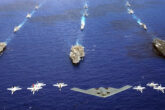March 07, 2018
Lessons for the Navy from SpaceX and the Commercial Sector
The United States Navy has a goal of increasing its fleet from its current inventory of 280 ships to 355, but its recently released 30-year shipbuilding plan does not reach that goal until the 2050s. This is despite the fact that the recently released national-security strategy publicly recognizes that the United States is now in a great-power competition with China and Russia. In addition, China’s investments in its own navy will enable it to surpass the U.S. Navy in size within the next decade; China may supplant the United States as the most influential nation on the global scene shortly after that. If the United States is to maintain its role as the key player, it will have to make changes in the way it approaches building and maintaining instruments of national power. Fortunately, there are some good examples of how to do this.
Just over a decade ago, the U.S. government engaged in a public-private partnership with Elon Musk’s fledgling space-launch company, SpaceX, to create a hybrid company that paired private capital with government funds. In the beginning, with the Space Shuttle program approaching its end, the partnership aimed to find an affordable method for launching resupply missions to the International Space Station. As the program matured, however, it became something much greater: a commercial business that overcame massive infrastructure costs to become a core part of the nation’s launch enterprise, all within the space of a decade.
Read the full article in National Review.
More from CNAS
-
Defense / Indo-Pacific Security
Is the U.S. Ready for War with China?U.S. military planners are caught in an impossible dilemma....
By Franz-Stefan Gady
-
The Pentagon Is Using Artificial Intelligence Right Now. Here’s How.
Artificial intelligence is the future of the military, or so Pentagon leaders keep saying. But is it the future — or is that future already here? That’s the question Breaking ...
By Josh Wallin
-
Stuck in the Cul-de-Sac
For more than a decade, the United States has sought to modernize its military to deter China, but it has become stuck in a developmental cul-de-sac that has allowed China to ...
By Carlton Haelig & Philip Sheers
-
Defense / Transatlantic Security
MWI Podcast: Europe’s Airspace Violations and the Counterdrone ChallengeJohn Amble is joined on this episode of the MWI Podcast by Dr. Stacie Pettyjohn, a senior fellow and director of the Defense Program at the Center for a New American Security....
By Stacie Pettyjohn




